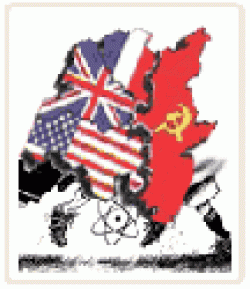 Among these movements were those dedicated to Afro-Asian
Among these movements were those dedicated to Afro-Asian
 NATO’s Purpose After the Cold War Throughout history military alliances have formed to balance either countervailing power or the perceived threat thereof.
NATO’s Purpose After the Cold War Throughout history military alliances have formed to balance either countervailing power or the perceived threat thereof.

Origin of Cold War: There is no unanimity amongst scholars regarding the origin of the Cold War In 1941 when Hitler invaded Russia, Roosevelt the President of USA sent armaments to Russia. Under Kwame Nkrumah's leadership Ghana became a prominent international player in the various movements created in the ideological space between the US and USSR during the Cold War. Between East and West: The Cold War's legacy in Africa 'Red Africa': From a generation of cinematographers to the end of apartheid - Africa, Cuba and the Soviet Union. This comprehensive study of China's Cold War experience reveals the crucial role Beijing played in shaping the orientation of the global Cold War and the confrontation between the United States and the Soviet Union. The Cold War was between the US (and its allies) against the Soviet Union (and its allies). This provoked an arms and technology race between the two superpowers. Soviet Russia took the leadership of all the Communist Countries. U.S. Role in the World: Background and Issues for Congress Congressional Research Service 3 Though often referred to as if it is a fully developed or universally established situation, the liberal international order, like other international orders that preceded it, is incomplete in geographic reach and in … Title: The U.S. Role in Post-Cold War Europe: Significance of European Views of the New U.S. Administration Author: Marten van Heuven Subject: The ability of the Clinton administration to pursue policies of enlargement and multilateralism will depend on European perceptions and rest in part on how Washington can shape European views. THE WAR OF THE INDUSTRIAL REVOLUTION: NEW TECHNOLOGY 48. There were no direct military campaigns between the United States … During World War II the global community saw the allegiance of the “United States”, ” France”, the “Soviet Union” in addition to “Great Britain”. The Cold War This theme will explore the reasons for U.S. involvement in the Vietnam War from a global perspective. USA in the period after the Cold War from the point of hegemonic stability theories, while at the end indicates the diversity of understanding of contemporary thinkers regarding the po hegemon or rather “just” a global leader. For most part (in most case) we were just spectators and didn't take part in the Cold War. The success of China's Communist revolution in 1949 set the stage, Chen says. This other narrative denied the basic premise of the Cold War narrative, namely that there were only two sides, and Involvement of the United States in regime change in Latin America most commonly involved US backed Coups d' etat aimed at replacing left-wing leaders with right-wing, usually military and authoritarian regimes. One nation tried to reduce the power of other. The Arm Race The Arms Race became the focus of the Cold War. When, after independence, India pro-claimed itself neutral in the Cold War and began to vote in the United Nations in ways that re ected this position, its policy was based on this alternative narrative. It is only because the relationship between Roosevelt and Stalin was very good. NATO’s Purpose After the Cold War Throughout history military alliances have formed to balance either countervailing power or the perceived threat thereof. The Cold war lasted about 45 years. One major war ended and another to begin. Following World War II, the U.S. found itself facing off against its former ally, the Soviet Union, in Europe. Cold War - Cold War - Toward a new world order: In the course of the 1960s and ’70s, however, the bipolar struggle between the Soviet and American blocs gave way to a more-complicated pattern of international relationships in which the world was no longer split into two clearly opposed blocs. The Arm Race The Arms Race became the focus of the Cold War.
![]() Among these movements were those dedicated to Afro-Asian
Among these movements were those dedicated to Afro-Asian NATO’s Purpose After the Cold War Throughout history military alliances have formed to balance either countervailing power or the perceived threat thereof.
NATO’s Purpose After the Cold War Throughout history military alliances have formed to balance either countervailing power or the perceived threat thereof.
![]() Among these movements were those dedicated to Afro-Asian
Among these movements were those dedicated to Afro-Asian NATO’s Purpose After the Cold War Throughout history military alliances have formed to balance either countervailing power or the perceived threat thereof.
NATO’s Purpose After the Cold War Throughout history military alliances have formed to balance either countervailing power or the perceived threat thereof.